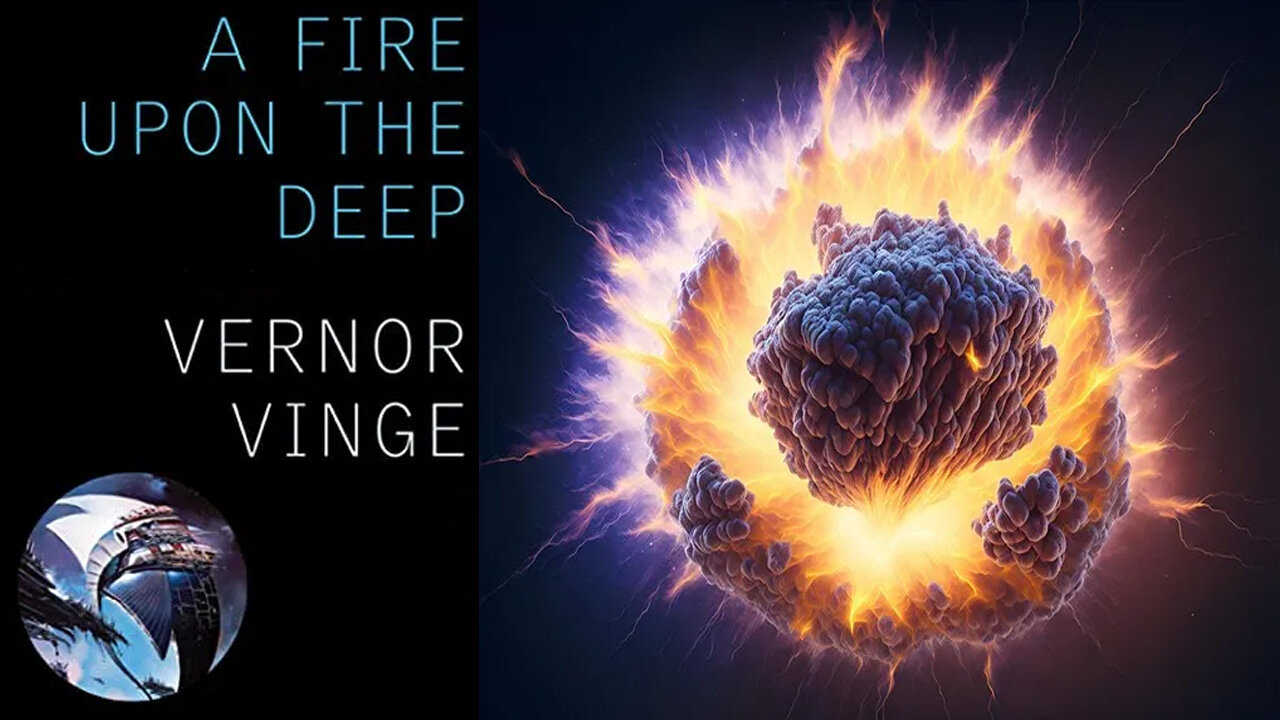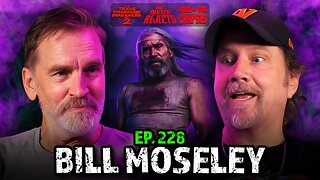Premium Only Content

'A Fire Upon the Deep' (1992) by Vernor Vinge
Vernor Vinge’s 'A Fire Upon the Deep' (1992) is one of those rare science fiction novels that manages to feel both mythic and rigorously scientific, a work that treats the future not merely as a setting but as a philosophical landscape. At first glance, it resembles a space opera in the tradition of Olaf Stapledon or Iain M. Banks: there are godlike entities, vast interstellar wars, and desperate human survivors adrift among alien civilisations. Yet underneath the scale and spectacle lies a very precise thought experiment about the nature of intelligence, its limits, and the peril of its expansion. The book’s universe is built on a single brilliant conceit—the Zones of Thought—in which the galaxy is divided into regions that determine how smart beings can be and how advanced their technologies may become. In the Slow Zone, akin to our own space, minds are bound by ordinary physics. In the Beyond, intelligence accelerates and faster-than-light travel is possible. Beyond that again, in the Transcend, intellects evolve into Powers so great that they are barely distinguishable from gods. This is not only a narrative device but a metaphor for hierarchy itself: the higher one climbs toward omniscience, the less recognisable life becomes, and the greater the risk of catastrophe.
The novel begins with one of those catastrophes. A scientific outpost in the Beyond inadvertently awakens an ancient digital god—a malign superintelligence known as the Blight—that begins consuming the minds of entire species across the galaxy. The story splits into two threads. One follows a small group of spacefaring humans and aliens who discover a possible countermeasure to the Blight and undertake a perilous rescue mission. The other, set on a planet deep in the Slow Zone, depicts a primitive species called the Tines, doglike creatures whose intelligence exists only collectively in small packs. The Tines’ society, built on group-minds, hierarchy, and sound, forms a strange mirror to the galactic drama. Vinge alternates between the cosmic and the local, showing how intelligence, whether human, alien, or machine, must always negotiate its own boundaries.
What makes the novel remarkable is how Vinge sustains these two scales without one trivialising the other. The scenes with the Tines have the immediacy of medieval political intrigue—betrayal, faith, discovery—while the outer story moves through the vertigo of posthuman space, where information travels faster than light and communication networks carry the voices of a thousand civilizations. The contrast between the Tines’ slow, organic intelligence and the Blight’s incomprehensible godhood gives the novel its moral centre. Intelligence is not a pure good. It is an unstable force, creative and destructive, and Vinge writes it with both awe and dread.
The tone of the novel is often detached, even austere. Vinge is not a stylist in the lyrical sense, but his language has the precision of engineering. He is meticulous in constructing plausible technologies and alien psychologies. At times the exposition threatens to overwhelm the reader, but the reward for persistence is a world of astonishing coherence. The galactic “Net,” for example—a kind of Usenet-like forum connecting thousands of species—feels prophetic of the modern Internet, complete with rumor, chaos, and misinformation. Through it, Vinge explores how communication both enables and confuses intelligence, and how even godlike minds remain vulnerable to the noise of their own networks.
There is also a strain of tragedy that runs beneath the book’s vast machinery. The Tines’ children, stranded survivors from a crashed human ship, become symbols of the fragile human core within all this cosmic strangeness. Their story grounds the novel emotionally, reminding the reader that even in a universe populated by transcendent Powers, survival still depends on loyalty, empathy, and trust. When the two plotlines converge in the final act, the effect is less a conventional climax than a kind of release—a moment where the personal and the cosmic briefly align before the machinery of the universe resumes its indifferent motion.
Reading 'A Fire Upon the Deep' today, it feels astonishingly prescient. Vinge, who later popularised the concept of the technological Singularity, anticipates the anxieties of our own century: the rise of artificial intelligence, the instability of information systems, and the ethical vacuum of power without comprehension. Yet the book never collapses into despair. Its vision is too large, too curious, for cynicism. Even as it warns of minds too vast to fathom, it celebrates the small, fallible intelligences—the humans, the Tines—that endure within their limited zones, aware of the abyss but still choosing to act.
Vinge’s novel is not flawless. It can be dense, slow, and sometimes emotionally cold. But it is never lazy. Every detail, from the physics of the Zones to the social patterns of the Tines, serves the same grand idea: that consciousness is both a miracle and a danger, a fire upon the deep that lights the darkness and threatens to consume itself. The result is a work of science fiction that earns the word “epic” without sentimentality or exaggeration. It imagines not only what intelligence can achieve, but what it must fear in its own reflection.
-

BonginoReport
2 hours agoDark Brandon Returns - Nightly Scroll w/ Hayley Caronia (Ep.164)
29.4K23 -
 49:24
49:24
Donald Trump Jr.
3 hours agoPeter Navarro Went to Prison So You Won't Have to | TRIGGERED Ep,286
16.2K26 -
 LIVE
LIVE
Nerdrotic
12 hours agoNerdrotic at Night 528
358 watching -
 1:16:12
1:16:12
Kim Iversen
3 hours agoTrump Might Actually Run For A THIRD Term?! | Turbo Cancers Are Rising—Media Pretends It’s Fine
50.1K36 -
 1:09:38
1:09:38
TheCrucible
2 hours agoThe Extravaganza! EP: 60 with Special Guest: Vince Offer (10/27/25)
54.2K4 -
 1:04:18
1:04:18
Candace Show Podcast
4 hours agoCharlie's Angels Or Demons? Disturbing Footage Emerges. | Candace Ep 252
58.7K209 -
 LIVE
LIVE
Quite Frankly
6 hours agoThe Forest King, NPC Nation, Calls & EXTRAS | Lubomir Arsov 10/27/25
337 watching -
 LIVE
LIVE
The Mike Schwartz Show
2 hours agoTHE MIKE SCHWARTZ SHOW Evening Edition 10-27-2025
135 watching -
 13:53
13:53
Tundra Tactical
3 hours agoGlock Apocalypse - Tundy Meme Review
2.66K1 -
 LIVE
LIVE
Jamie Kennedy
15 hours agoThe Macabre Mind of Bill Moseley: Horror, Philosophy & the Spirit of Darkness| Ep 228 HTBITY
86 watching